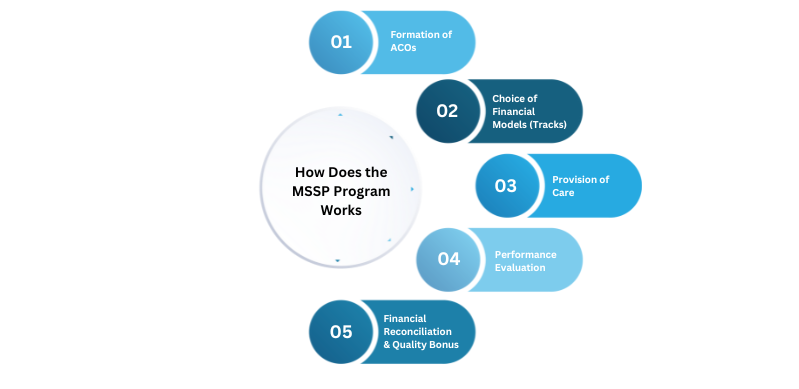
How Long are Medical Records Kept
How Long are Medical Records Kept After the post-pandemic era, where an increase in patient telehealth services was seen, the importance of medical records was

With the ever-changing healthcare landscape, the quest for efficiency and quality has never been more critical. MSSP program has been a game changer in transitioning the healthcare system from a volume-based model to a value-based one. Incentivizing the ACO to take financial risks in exchange for potential rewards has made some significant changes in the healthcare outcomes of patients while reducing their overall expenses.
So, as a healthcare provider, if you are wondering how this program functions, what risk levels are associated with it, and how it is revolutionizing the entire healthcare system, then you are at the right place. Just stay with us, and this blog will clear most of the confusion in your mind.
MSSP stands for Medicare Shared Service Program, which is a type of (Alternative Payment Model) that lies under the CMS Quality Payment Program. This program was designed to follow a value-based care model that prioritizes the hospitals, physicians, and ACO members to work in collaboration to enhance the quality of healthcare outcomes while lowering the cost of service.
CMS first introduced the MSSP program back in 2012. The main aim for CMS to introduce this model was to shift the system from fee for service model to a value-based service model. But what does that mean? In simple terms, it means instead of paying the healthcare providers for every service they provide to a patient, CMS will incentivize them based on the quality of care provided and overall cost savings. In 2012, there were only 220 ACOs that were participating in the MSSP program. However, as of 2018, this number has grown to over 561 MSSP ACOs.
ACO stands for Accountable Care Organization, ACO definition is a group of healthcare providers and facilities that work together to provide coordinated care and shared accountability for the quality and cost of patient care. ACOs are the backbone of the MSSP program as they are responsible for managing and coordinating care for Medicare beneficiaries.
Here’s a step-by-step breakdown of how the MSSP program works:

Formation: Healthcare providers form an ACO and enter into a formal agreement with the Centers for Medicare & Medicaid Services (CMS).
Eligibility: The ACO must serve a minimum of 5,000 Medicare beneficiaries and commit to participating in the program for at least three years.
Selection of Financial Risk Track: The ACO selects one of the financial risk tracks offered by MSSP—Basic, Enhanced, or others—which dictates the level of risk and potential rewards the ACO is willing to assume. Each track has specific rules regarding shared savings and losses.
Benchmarking: CMS sets financial benchmarks based on past Medicare costs for the population the ACO will serve.
Patient Care: Healthcare providers within the ACO coordinate to offer high-quality care to their Medicare patients.
Data Collection: The ACO continuously gathers data on the quality of care, including patient satisfaction, readmissions, and other quality measures outlined by CMS.
Annual Reporting: At the end of each performance year, the ACO submits data to CMS on a variety of quality measures, along with financial data.
Assessment: CMS compares the ACO’s actual expenditures against the established benchmarks and evaluates the ACO’s performance on quality measures.
Shared Savings or Losses: If the ACO provides care at a cost below the benchmark and meets quality standards, it receives a share of the savings. Conversely, in certain tracks, if costs exceed benchmarks, the ACO may have to repay a portion of the excess expenditure to CMS.
Distribution: Any earned shared savings are distributed among the ACO’s members according to their agreement.
Adjustments: The ACO can use insights from performance metrics and financial outcomes to make improvements for the next performance year.
By engaging healthcare providers in both the risks and rewards associated with patient outcomes and costs, the MSSP aims to create a healthcare system that values quality over quantity. The program encourages continuous improvement and innovation in the provision of care.
The Medicare Shared Savings Program (MSSP) offers different financial model tracks that dictate how Accountable Care Organizations (ACOs) share in savings or losses. These tracks are designed to encourage healthcare providers to improve care coordination, improve patient outcomes, and reduce healthcare costs. Below are some of the most commonly used financial model tracks
The Basic Track is designed for ACOs that are less experienced with risk-based models. It has a glide path with five levels (A-E), offering an incremental approach to assuming more risk.
This track is designed for more experienced ACOs willing to take on higher levels of risk and potential reward right from the start. ACOs in this track can achieve a higher percentage of shared savings but also risk a greater percentage of shared losses.
Before the introduction of the “Pathways to Success” program, the MSSP initially featured three main tracks:
Track 1: This was a one-sided model, where ACOs had no downside financial risk. They only shared in the savings.
Track 1+: A transitional track that allowed for lower downside risk than Tracks 2 and 3 as a stepping stone for organizations preparing to assume more risk.
Track 2 and Track 3: These were both two-sided models, meaning ACOs shared in both savings and losses. These tracks were designed for more experienced ACOs and had higher rates of shared savings and risk.
Each track also has various financial caps, thresholds, and limits which further define the risk and reward profile. For instance, the percentage of shared savings an ACO can earn, and the maximum amount of loss it might be responsible for, are determined based on the chosen track.
Risk adjustment methodologies and financial benchmarks also vary by track, affecting how CMS calculates both expected and actual expenditures for an ACO’s beneficiary population.
Choosing the appropriate financial model track is a strategic decision for ACOs, requiring them to assess their own capabilities, risk tolerance, and goals for improving patient care while reducing costs.
The MSSP program is a valuable opportunity for healthcare providers to collaborate and drive positive changes in the delivery of Medicare services. By offering different financial models it allows ACOs to choose their preferred level of risk and reward while incentivizing them to prioritize quality care.
With continuous improvement and innovation, the MSSP aims to create a sustainable healthcare system that benefits both patients and providers. As healthcare continues to evolve, the MSSP will undoubtedly play an essential role in shaping its future.

How Long are Medical Records Kept After the post-pandemic era, where an increase in patient telehealth services was seen, the importance of medical records was

What Is Telemonitoring & How It is shaping the Healthcare industry Gone are the days of frequent hospital visits and lengthy waits in crowded waiting
Talk to an Expert Now